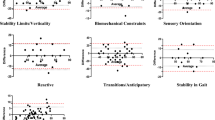Abstract
Introduction
Based on the literature, reliability reports and normative data for bilateral stance assessments in elementary schoolchildren are limited. The present study was designed to report test-retest reliability and reference values for postural stability in 9 to 10 years old schoolchildren using the Balance Master system.
Materials and methods
Twenty children participated in the reproducibility study (mean age 10.1±0.7) including test and retest measurement with a one-week interval. The modified clinical test of sensory interaction on balance (mCTSIB) quantified children’s static standing balance. The test for the limits of stability (LOS) measured dynamic standing balance. The study sample to determine reference values consisted of 99 children (mean age 9.8±0.5).
Results
The ICCs for inter-item reliability of the four sensory conditions of the mCTSIB showed fair to excellent reliability (ICCs between 0.62 and 0.80). The reproducibility between test and retest was non-significant for the condition ‘firm surface with eyes closed’ (ICC of 0.37), fair to good for the three other sensory conditions (ICCs between 0.59 and 0.68), and excellent for the composite sway velocity (ICC of 0.77). For all LOS parameters, the significant ICCs showed fair to good reproducibility (ICCs between 0.44 and 0.62), with the exception of the non-significant ICC for the composite reaction time. The ICCs for the separate LOS parameters showed fair to good and excellent reliability for nine parameters (ICCs between 0.46 and 0.81), while 11 separate LOS scores did not demonstrate significant ICCs.
Discussion
Analysing reference values, girls performed better on all the composite balance parameters compared to boys, with the exception of reaction time and movement velocity. No differences were found on standing balance scores between 9 and 10 year olds.
Conclusion
In conclusion, the Balance Master showed fair to good reliability for most postural parameters in 9 to 10 year olds. The current data on postural control in children aged 9 to 10 years are relevant for research in other domains within the clinical field, like obesitas and developmental coordination disorder or in relation to back pain prevalence at early age.
Similar content being viewed by others
Abbreviations
- COP:
-
Centre of pressure
- COG:
-
Centre of gravity
- mCTSIB:
-
Modified clinical test of sensory interaction
- LOS:
-
Limits of stability
- ICC:
-
Intraclass correlation coefficient
References
Atwater SW, Crowe TK, Deitz JC, Richardson PK (1990) Interrater and test-retest reliability of two pediatric balance tests. Phys Ther 70:79–87
Baker CP, Newstead AH, Mossberg KA, Nicodemus CL (1998) Reliability of static standing balance in nondisabled children. Pediatr Rehabil 2:15–20
Birmingham T (2000) Test-retest reliability of lower extremity functional instability measures. Clin J Sport Med 10:264–268
Brouwer B, Culham EG, Liston RA, Grant T (1998) Normal variability of postural measures: implications for the reliability of relative balance performance outcomes. Scand J Rehabil Med 30:131–137
Cambier D, Cools A, Danneels L, Witvrouw E (2001) Reference data for 4- and 5-year-old-children on the Balance Master: values and clinical feasibility. Eur J Pediatr 160:317
Emery CA, Cassidy JD, Klassen TP, Rosychuk RJ, Rowe BB (2005) Development of a clinical static and dynamic standing balance measurement tool appropriate for use in adolescents. Phys Ther 85:502–514
Figura F, Cama G, Capranica L, Guidetti L, Pulejo C (1991) Assessment of static balance in children. J Sports Med Phys Fitness 31:235–242
Fleiss JL (1986) Analysis of data from multiclinic trials. Control Clin Trials 7:267–275
Gabriel LS, Mu K (2002) Computerized platform posturography for children: test-retest reliability of the sensory test of the VSR system. Phys Occup Ther Pediatr 22:101–117
Hatzitaki V, Zisi V, Kollias I, Kioumourtzoglou E (2002) Perceptual-motor contributions to static and dynamic balance control in children. J Mot Behav 34:161–170
Lafond D, Corriveau H, Hebert R, Prince F (2004) Intrasession reliability of center of pressure measures of postural steadiness in healthy elderly people. Arch Phys Med Rehabil 85:896–901
Lebiedowska MK, Syczewska M (2000) Invariant sway properties in children. Gait Posture 12:200–204
Lee HY, Cherng RJ, Lin CH (2004) Development of a virtual reality environment for somatosensory and perceptual stimulation in the balance assessment of children. Comput Biol Med 34:719–733
McEvoy MP, Grimmer K (2005) Reliability of upright posture measurements in primary school children. BMC Musculoskelet Disord 6:35–45
Nolan L, Grigorenko A, Thorstensson A (2005) Balance control: sex and age differences in 9- to 16-year-olds. Dev Med Child Neurol 47:449–454
Pollock AS, Durward BR, Rowe PJ, Paul JP (2000) What is balance? Clin Rehabil 14:402–406
Riach C, Starkes J (1994) Velocity of centre of pressure excursions as an indicator of postural control systems in children. Gait Posture 2:167–172
Rival C, Ceyte H, Olivier I (2005) Developmental changes of static standing balance in children. Neurosci Lett 376:133–136
Schmid M, Conforto S, Lopez L, Renzi P, D’Alessio T (2005) The development of postural strategies in children: a factorial design study. J Neuroengineering Rehabil 30:29–39
Acknowledgements
This study is part of a broader research project entitled: Sport, Physical Activity and Health, carried out by a consortium of researchers from KULeuven, Ghent University and VUBrussels, funded by the Flemish Government.
Author information
Authors and Affiliations
Corresponding author
Rights and permissions
About this article
Cite this article
Geldhof, E., Cardon, G., De Bourdeaudhuij, I. et al. Static and dynamic standing balance: test-retest reliability and reference values in 9 to 10 year old children. Eur J Pediatr 165, 779–786 (2006). https://doi.org/10.1007/s00431-006-0173-5
Received:
Accepted:
Published:
Issue Date:
DOI: https://doi.org/10.1007/s00431-006-0173-5




